Learn about the different species of chameleon available as pets
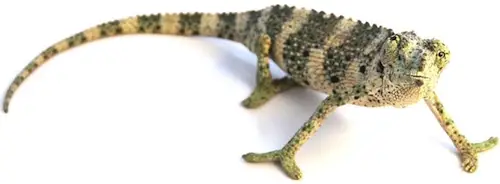
Types of Chameleons
Types of chameleons
Here I’ll highlight several different types of pet chameleon species, including a few of my favorites. Some are commonly available in the reptile market, and some are a little more rare.
Each chameleon is a work of art, and I do believe there’s a species to suit each individual hobbyist. Here are the types of chameleons that I have found to be particularly entertaining, impressive, and fascinating. Some of them will also make my list of the best pet chameleons.
Here I’ll highlight several different types of pet chameleon species, including a few of my favorites. Some are commonly available in the reptile market, and some are a little more rare.
Each chameleon is a work of art, and I do believe there’s a species to suit each individual hobbyist. Here are the types of chameleons that I have found to be particularly entertaining, impressive, and fascinating. Some of them will also make my list of the best pet chameleons.
Veiled chameleon (Chamaeleo calyptratus)
“Veileds” are the type of chameleon that will always be near and dear to my heart. My first chameleons ever were a pair of these, around 4-inches long. I had a blast raising them up in separate cages and eventually bred them together to produce a clutch of 58 eggs. I was elated—what an experience!
This species reaches impressive sizes, and they do really well in captivity—definitely the best of any chameleon I’ve ever kept. I think it may have to do with the fact that they originally hail from Yemen and Saudia Arabia, which means they’re probably very tolerant of harsh conditions. Nowadays, in the U.S., they’re all captive bred.
“Veileds” are the type of chameleon that will always be near and dear to my heart. My first chameleons ever were a pair of these, around 4-inches long. I had a blast raising them up in separate cages and eventually bred them together to produce a clutch of 58 eggs. I was elated—what an experience!
This species reaches impressive sizes, and they do really well in captivity—definitely the best of any chameleon I’ve ever kept. I think it may have to do with the fact that they originally hail from Yemen and Saudia Arabia, which means they’re probably very tolerant of harsh conditions. Nowadays, in the U.S., they’re all captive bred.
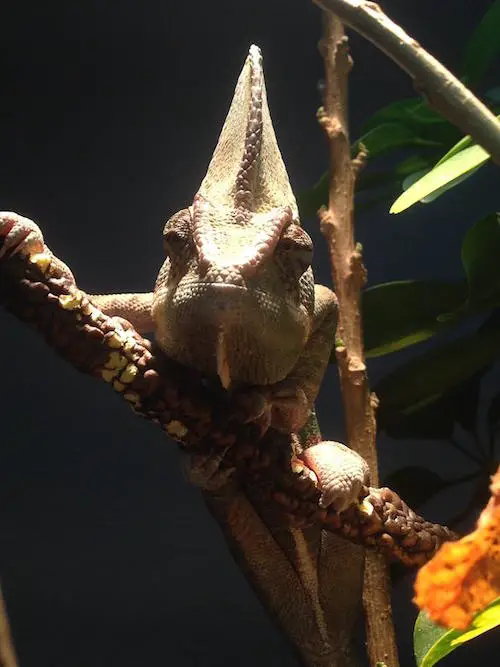
Their casques (the tall bony structure on the top of their head) give them a totally unmistakable appearance, and they’ll eat just about anything, even leaves at times. However, I’d hesitate to call them “omnivorous.”
Breeding them is pretty simple, certainly the easiest of any chameleon, and they lay a lot of eggs. The largest clutch I’ve ever received was 67 eggs. The babies are about as cute as it gets, and they’ve got attitude right out of the gate. The adults, especially the males, are perhaps the most aggressive chameleons in the world.
Meller’s Chameleon (Chamaeleo melleri)
In my experience, Meller’s are the type of chameleon that makes folks say, “Whoa!” People just aren’t ready for their size and overall massive size. They’re the largest chameleon species in Africa, but not Madagascar, the gigantic island right off Africa’s East coast.
Some claim to have seen specimens around 30-inches, but the largest I’ve ever had was right around 25-inches, and I’ve purchased hundreds of adults.
Their grip is strong and their claws are sharp. I never wear leather gloves when I handle my chameleons, no matter the species, because it dampens your touch sensitivity and I want to make sure I’m never applying to much pressure or inadvertently handling them too rough. As a result, with Meller’s, I’m usually bleeding a bit afterwards.
In my experience, Meller’s are the type of chameleon that makes folks say, “Whoa!” People just aren’t ready for their size and overall massive size. They’re the largest chameleon species in Africa, but not Madagascar, the gigantic island right off Africa’s East coast.
Some claim to have seen specimens around 30-inches, but the largest I’ve ever had was right around 25-inches, and I’ve purchased hundreds of adults.
Their grip is strong and their claws are sharp. I never wear leather gloves when I handle my chameleons, no matter the species, because it dampens your touch sensitivity and I want to make sure I’m never applying to much pressure or inadvertently handling them too rough. As a result, with Meller’s, I’m usually bleeding a bit afterwards.
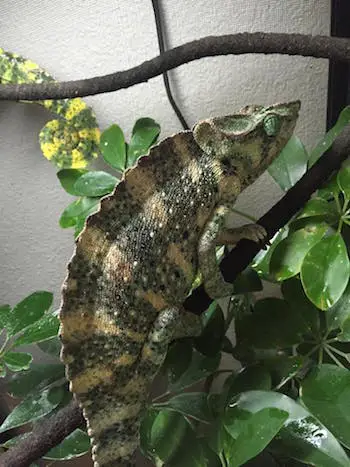
Meller’s chameleons are sometimes referred to as “Bird-eating chameleons” because they apparently will pick-off small birds on occasion. in my experience, there’s quite a variety in color and pattern. I’ve had some that were bright green, dark green, and nearly white with green patterning.
They tend to be the type of chameleon that is more apt to bite than flee. Generally, new imports attempt to snap first and ask questions later. It’s ok, because they generally calm down a bit with time.
Four-horned Chameleon (Trioceros quadricornis)
“Quads” as they’re called, are a wonderful species that are very rare to come across in the reptile market. They’re the type of chameleon that can be a centerpiece in a collection. Their tall tail crest is unmistakeable, and they can have up to eight horns, making them absolutely one-of-a-kind! Definitely a crown jewel of the chameleon world.
“Quads” as they’re called, are a wonderful species that are very rare to come across in the reptile market. They’re the type of chameleon that can be a centerpiece in a collection. Their tall tail crest is unmistakeable, and they can have up to eight horns, making them absolutely one-of-a-kind! Definitely a crown jewel of the chameleon world.
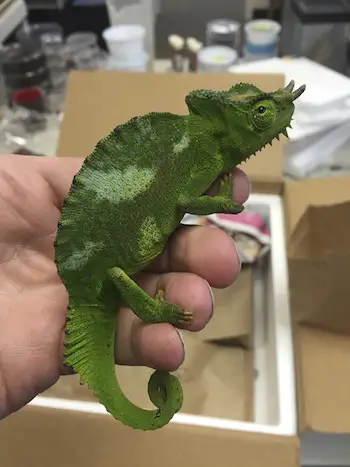
They usually do extremely well in captivity. I once had 54 imports arrive fresh from Cameroon, of which 95% went on to thrive for me and my customers. I’ve also had quite a few eggs laid by gravid imports, of which nearly all hatched successfully. Certainly one of my favorite species.
Females lack the horns and the high tail crest. Males are more visually impressive and can even have blue coloration. There’s even a subspecies, Trioceros q. gracilior, that has red claws. I’ve hatched eggs from this subspecies as well.
To quote Ferris Bueller, “It is so choice. If you have the means, I highly recommend picking one up.”
Oustalet’s Chameleon (Furcifer oustaleti)
Oustalet’s, pronounced “oo—stuh—lays,” are also known as Malagasy giant chameleons, and named after French biologist Jean-Frederic Emile Oustalet’s. Malagasy is also the language spoken on the island of Madagascar, where these beasts hail from originally.
They can handle dry environments and generally do extremely well in captivity. They’re the contested largest chameleons in the world, reaching lengths of 27-28 inches, if length is the barometer. They are leaner than Parson’s chameleons, however.
Oustalet’s, pronounced “oo—stuh—lays,” are also known as Malagasy giant chameleons, and named after French biologist Jean-Frederic Emile Oustalet’s. Malagasy is also the language spoken on the island of Madagascar, where these beasts hail from originally.
They can handle dry environments and generally do extremely well in captivity. They’re the contested largest chameleons in the world, reaching lengths of 27-28 inches, if length is the barometer. They are leaner than Parson’s chameleons, however.
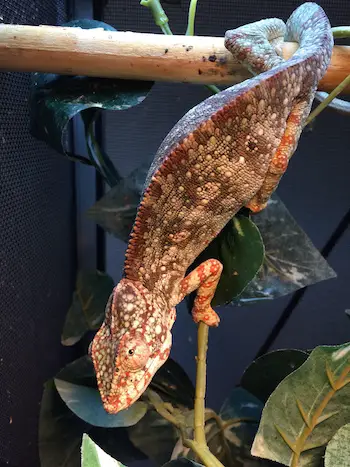
I’ve raised captive hatched baby Oustalet’s to adults, bred them, then raised their babies. They’re a highly underrated species that I consider a top-five pet chameleon.
Contrary to some pictures you might see online, they can have bright red markings, and not just a dull brown. Females tend to be more colorful than males, which is unusual in the chameleon world.
Parson’s Chameleon (Calumma parsoni)
Parson’s chameleons, once you witness one in person, will leave you contemplating how to get one. They may not be the longest chameleons in the world, but they’re certainly the heaviest and most impressive. Unfortunately, their price tag reflects their awesomeness, rarely offered for less than $1,000. They’re the type of chameleon that embodies the wow factor.
Parson’s chameleons, once you witness one in person, will leave you contemplating how to get one. They may not be the longest chameleons in the world, but they’re certainly the heaviest and most impressive. Unfortunately, their price tag reflects their awesomeness, rarely offered for less than $1,000. They’re the type of chameleon that embodies the wow factor.
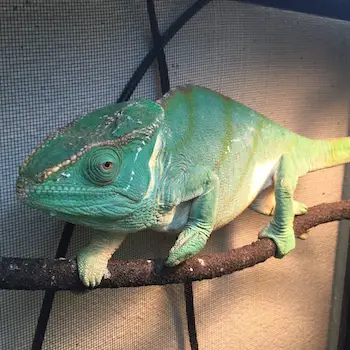
One day I purchased a healthy-looking Yellow-lip Parson’s pair from an importer. The female sure looked plump, but you never know. They thrived and I sold the male, but kept the female as I thought she might be gravid. Eventually, she did lay eggs…68 of them. They’re still incubating, so we’ll see. The female is pictured above—she’s still my favorite chameleon, still thriving and a real sweetheart.
Carpet Chameleon (Furcifer lateralis)
Carpet chameleons are the types of chameleons that get people into the hobby. Why? Because they’re small, manageable, and gorgeous. Pictured below is one of my more colorful specimens. They’re also easy to breed.
Carpet chameleons are the types of chameleons that get people into the hobby. Why? Because they’re small, manageable, and gorgeous. Pictured below is one of my more colorful specimens. They’re also easy to breed.
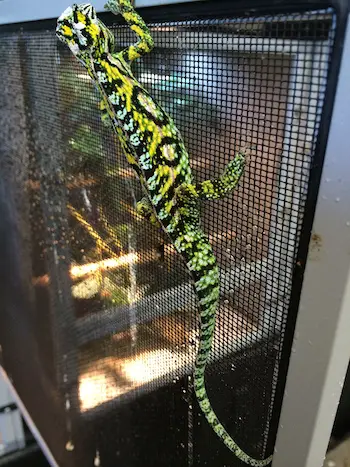
Despite the notion that they’re easy to breed, I’ve found the eggs to be the most difficult to hatch of all chameleon species I’ve incubated, and that’s out of nearly 20 species. I’ve hatched them out successfully, but not at the high rate to which I’m now accustomed.
That doesn’t mean they don’t make excellent pet chameleons. They’re fantastic and I highly recommend them as even a starter chameleon. Fresh imports can be a little sketchy, but captive bred specimens are highly recommended.
